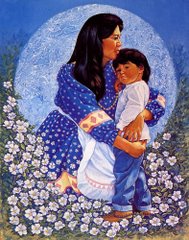What is good about it?
How is it lacking?
Is there a problem with it?
Bill C-31 http://research2.csci.educ.ubc.ca/indigenation/Indian_ReACTions/Indian_ReACTions/BillC-31.htm
To be an Indian in Canada is not just a cultural identity but also a legal category. The Canadian State, rather than aboriginal communities themselves, has, through the Indian Act of Canada, historically legislated who is an Indian. One of the most glaring examples of the inequities embedded in this process is the treatment of women. Until 1985, with the passing of Bill C-31:
Status Indian men who married white women,
- kept their status and
- their enrollment in their bands;
- their wives became status Indians, and
- their children were considered to be status Indians.
But
Status Indian women who married white men (or even non-status Indian men or Métis men)
- lost their status and
- lost the right to pass this status to their children.
- Additionally, they lost their right to be band members and
- were not permitted to live on reserves.
- Even upon the dissolution of the marriage, these women were not able to regain their status and then rejoin their families in their communities.
As early as the 1950’s, activists like Mary Two-Axe Earley of Kahnawake and Nellie Carlson of Saddle Lake made legal challenges against this sexist provision of the Indian Act. (Dickason, 313). Events like the 1979 Aboriginal Women’s Walk from Oka to Ottawa brought this issue to national attention.
It was not until June 28, 1985, that Parliament passed Bill C-31, to bring the Act into line with the provisions of the Canadian Charter of Rights and Freedoms. "The three principles that guided the amendments to the Indian Act were:
Removal of discrimination;
Restoring status and membership rights; and
Increasing control of Indian bands over their ownaffairs."
These amendments, however, have not been celebrated universally. The State still controls the Indian registry, which is contended as a point of principle by those who believe that "Indian nations have the inherent right to define citizenship” (Monture-Angus, 188).
Also, Bill C-31 introduces the second generation cut-off rule, where only those who have two status Indian grandparents can claim status. This means that if a status Indian person with only one registered Indian parent wants to pass on their status and right to a place in their bands and on reserve to their children, they must choose to have children with another status Indian. The sexism of previous legislation has been replaced with a form of a blood quantum rule. To be status Indian in Canada continues to be a category not based on cultural affiliation but rather legislation by the government who determines who is an Indian.
Several women have written about the effect Bill C-31 has had on their lives. While many have celebrated their legal reinstatement in communities, they are still critical of the role the state has played. Ada Doreen, born in 1926, in an interview with celebrated author Beth Brant, published in I'll Sing 'til the Day I Die, speaks scathingly of her situation:
The government never gave a damn about us, except to tell us what to do. Now,Report of the Royal Commission on Aboriginal Peoples - VOLUME 4 Perspectives and Realities from 2 Women's Perspectives:
people think the government is a saviour. Well, I don't. They're the ones told
us our language wasn't any good. And they're the ones took away my status
because I married Amos, and he's from St. Regis. He was as Indian as me, but
wasn't registered. Can you imagine that?! If it wasn't for the Native women
going to court, I'd still be considered a "foreigner." (97)
http://www.ainc-inac.gc.ca/ch/rcap/sg/sj3_e.html ,
http://www.ainc-inac.gc.ca/ch/rcap/sg/sj4_e.html ,
http://www.ainc-inac.gc.ca/ch/rcap/sg/sj5_e.html ,
Information sheets produced by the Communications Branch, Department of Indian Affairs and Northern Development. http://www.johnco.com/nativel/bill_c31.html
Three booklets issued by the Native Council of Canada to assist unregistered Indians to apply for status under the Indian Act following the passage of Bill C-31 in 1985. http://www.abo-peoples.org/programs/C-31/c-31.html
Bill C-31: The Abocide Bill by Harry W. Daniels Former President , Congress of Aboriginal Peoples http://www.abo-peoples.org/programs/C-31/Abocide/Abocide-1.htm

No comments:
Post a Comment